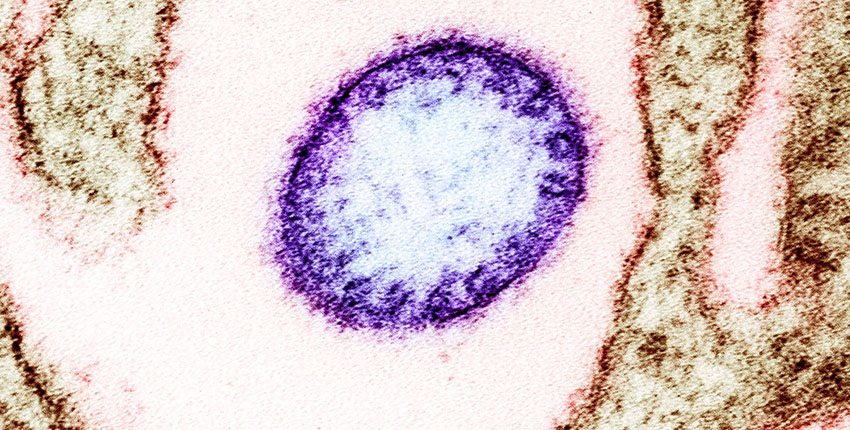Researchers at Boston University Chobanian & Avedisian School of Medicine and Harvard Medical School have mapped a crucial part of the Nipah virus, a deadly bat-borne infection responsible for human outbreaks nearly annually since it was discovered in 1999.
Their findings were published in the journal Cell.
This advances the development of urgently needed medications. There are currently no effective therapies for the disease other than supportive care, and there are no vaccines to prevent or lessen Nipah virus infection.
Humans and pigs can contract the virus, which fruit bats carry. Additionally, it can spread directly from person to person by coughing droplets and contaminated food. The Nipah virus has been designated a priority pathogen by the World Health Organization, which applies to organisms that have the potential to cause major epidemics and that urgently need study to guide preventative and treatment plans.
Researchers argue that because the Nipah virus may spread through respiratory secretions and airborne droplets, it has the potential to start a pandemic. The researchers also point out that evidence suggests that some infected individuals may still spread the virus even if they experience lesser, nonspecific symptoms.
In extreme situations, the infection may result in encephalitis, a type of inflammation of the brain that can cause fatal neurologic impairments, as well as severe respiratory sickness. The Centers for Disease Control and Prevention estimate that between 40 and 75 percent of infected people die from the infection. In contrast, the Ebola virus has an average death rate of 50% and kills between 25 and 90% of people infected during previous epidemics.
The viral polymerase complex, a collection of proteins the virus employs to replicate its genetic material, disseminate, and infect cells, was the focus of the recent study. The piece offers a thorough three-dimensional representation of the virus’s polymerase and its salient characteristics. It becomes clearer how the virus grows inside its hosts when the structure and behavior of this essential component of the viral machinery are understood.
The structure and function of the Nipah viral polymerase have not yet been well understood, according to researchers, who warned that more study is necessary to completely comprehend how the polymerase creates the many genetic components that allow the virus to proliferate.
However, the scientists stated that dismantling this component of the virus’s machinery is an essential first step in identifying the inner workings of a dangerous virus.
Identifying how the polymerase is regulated to switch on and switch off the different enzymatic activities that are required for viral replication would be game-changing, and this study represents a key step towards that goal.
Rachel Fearns
The molecular structure of the viral polymerase complex can be unraveled to give a basis for therapeutic design.
This new understanding can help us identify the functional properties of the polymerase structure that could be leveraged as drug targets.
Jonathan Abraham
After figuring out the structure of the enzyme, the researchers looked more closely at how its many components affect the various tasks it may accomplish. Critical hints for preventing the virus’s spread can be found by comprehending the functions of these various components and how they can take on various places.
The experiments were carried out in two separate methods by the researchers. Using cryo-electron microscopy, a method that enables researchers to see the structure of biologic samples at the scale of individual molecules, they first isolated the polymerase and ascertained its structure. Second, in order to determine how these changes impacted the polymerase’s function, they created mutations in the enzyme and then watched how the altered polymerase behaved in cells.
Elucidating both the unique and shared characteristics of the Nipah virus polymerases in comparison to other viral polymerases, our study provides critical insights that have the potential to inform the development of broad-spectrum antivirals.
Heesu Kim
The researchers point out that Georgia State University researchers have created a viable oral medication candidate that combats Nipah-related infections but not the Nipah virus itself.
The researchers performed a number of simulation tests to see whether structural modifications to the viral polymerase might enhance the medication’s capacity to bind to the virus in order to comprehend why this therapeutic candidate is ineffective against the Nipah virus. The scientists discovered a particular region of the viral polymerase that might be the target of a medication. The development of small-molecule inhibitors that interfere with the viral polymerase and make the Nipah virus treatable can then be influenced by this.
We hope that our findings will spark interest and stimulate additional research by others, enabling new insights into a deadly pathogen,
Indeed, we were excited to see other groups share their data openly just as we did and help move the field forward.
Side Hu
Source: Harvard Medical School – News
Journal Reference: Side Hu, Heesu Kim, Pan Yang, Zishuo Yu, Barbara Ludeke, Shawna Mobilia, Junhua Pan, Margaret Stratton, Yuemin Bian, Rachel Fearns, Jonathan Abraham. Structural and functional analysis of the Nipah virus polymerase complex. Cell, 2025; DOI: 10.1016/j.cell.2024.12.021
Last Modified:
Graduated from the University of Kerala with B.Sc. Botany and Biotechnology. Attained Post-Graduation in Biotechnology from the Kerala University of Fisheries and Ocean Science (KUFOS) with the third rank. Conducted various seminars and attended major Science conferences. Done 6 months of internship in ICMR – National Institute of Nutrition, Hyderabad. 5 years of tutoring experience.
Published Literature: https://www.sciencedirect.com/science/article/abs/pii/S0168160523000648







